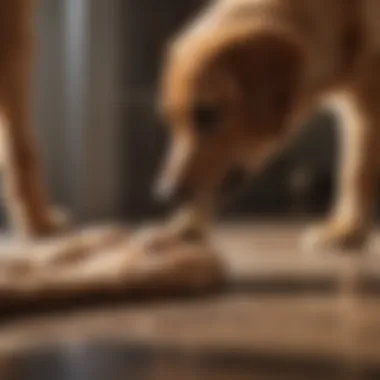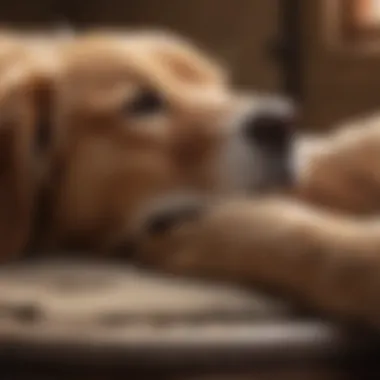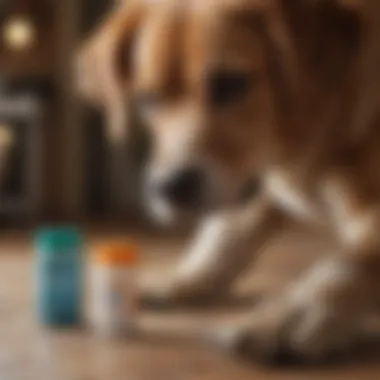Unraveling the Enigma of Dogs' Paw Licking Behavior: A Comprehensive Insight


Pet Care Essentials
Dogs are known for their curious habits, and one such behavior that often leaves pet owners puzzled is paw licking. This article aims to unravel the mysteries behind why dogs engage in this behavior. From environmental triggers to potential health concerns, pet parents can gain valuable insights into understanding and helping their furry companions. By delving into the common phenomenon of dogs licking their paws, this guide will provide a comprehensive look at the reasons behind this seemingly innocuous habit.
Behavior & Training
Understanding your pet's body language is key to deciphering why they lick their paws. Dogs communicate in subtle ways, and paw licking can be a form of expression. This section will delve into basic training techniques that can help address paw licking behavior. Additionally, behavioral concerns and solutions will be explored in detail, offering pet owners practical tips to encourage positive habits in their furry friends. Socialization tips will also be provided to help create a healthy and happy environment for pets.
Pet Home Environment
Creating a pet-friendly space is essential for promoting overall well-being. Safety measures and hazards to avoid will be highlighted to ensure a secure environment for pets. Choosing the right toys and accessories can also play a role in preventing excessive paw licking. Setting up a comfortable resting area is crucial for a pet's physical and mental health. This section will guide pet owners on creating an ideal home environment that reduces stress and promotes contentment.
Pet Health Issues
When it comes to paw licking, recognizing signs of illness is imperative. This section will outline preventative care measures to help maintain a pet's health and well-being. Common ailments that can lead to paw licking will be discussed, along with appropriate treatments. Emergency preparedness tips will be provided to equip pet owners with the knowledge to handle unforeseen health issues effectively. By delving into pet health issues related to paw licking, this guide will offer valuable insights for pet owners to ensure the optimal care of their beloved companions.
Introduction
Exploring the Paw Licking Behavior
When examining why dogs engage in paw licking behavior, two main aspects come to light: the natural grooming instinct and potential causes beyond grooming.
Natural Grooming Instinct
The natural grooming instinct in dogs is a deeply ingrained behavior that stems from their ancestors' grooming habits. Dogs lick their paws to maintain cleanliness, regulate body temperature, and establish a sense of comfort. This instinctual behavior is essential for dogs to upkeep their hygiene and physical well-being. Despite its importance, excessive paw licking can sometimes indicate underlying issues that require attention. Understanding the nuances of this grooming instinct is crucial for pet owners in monitoring and addressing their dog's behavior.
Potential causes beyond grooming


Beyond the natural grooming instinct, various factors can drive dogs to lick their paws excessively. These causes may include environmental triggers, such as dry or irritated skin, or the presence of allergens in the dog's surroundings. Additionally, behavioral triggers like anxiety, stress, or boredom can lead to increased paw licking. Recognizing and addressing these potential causes is essential in providing holistic care for your furry friend. By identifying the root of the behavior, pet owners can take proactive steps to support their dog's well-being.
Common Reasons for Paw Licking
Understanding the common reasons behind why dogs lick their paws is a crucial aspect that pet owners must grasp. This section delves into the various factors that can trigger paw licking behavior in dogs. By shedding light on environmental triggers, behavioral aspects, and potential medical conditions, pet owners can gain valuable insights into addressing their furry companion's needs effectively.
Environmental Factors
Dry or irritated skin
Dry or irritated skin plays a significant role in prompting dogs to lick their paws excessively. The discomfort caused by dryness or irritants on their skin can lead to constant licking as a means to alleviate the itch or pain. Understanding the nuances of dry or irritated skin is essential in identifying and addressing this common issue among dogs. Despite its prevalence, dry or irritated skin can be managed effectively through proper care and targeted treatments, ensuring your pet's comfort and well-being.
Presence of allergens
The presence of allergens in the environment can also contribute to paw licking behavior in dogs. Allergens such as pollen, dust, or certain foods can trigger allergic reactions in dogs, prompting them to lick their paws in response. Recognizing the impact of allergens on your dog's well-being is vital in preventing excessive paw licking. By minimizing exposure to allergens and providing necessary care, pet owners can help alleviate discomfort and promote healthier paw hygiene.
Behavioral Triggers
Anxiety or stress
Anxiety or stress in dogs can manifest through paw licking behavior as a coping mechanism. Dogs may turn to excessive paw licking when feeling anxious or stressed, seeking comfort or relief through this repetitive action. Understanding the signs of anxiety or stress in dogs is essential for addressing behavioral triggers effectively. By addressing the root cause of anxiety or stress and providing appropriate support, pet owners can help their dogs find alternative, healthier coping mechanisms.
Boredom or habit
Boredom or habit can also contribute to paw licking behavior in dogs. Dogs may develop a habit of licking their paws out of boredom or as a self-soothing mechanism. Recognizing the role of boredom or habit in paw licking is crucial in addressing this behavior proactively. Engaging dogs in stimulating activities, providing ample exercise, and introducing interactive toys can help curb boredom-related paw licking habits, fostering a healthier and more enriching environment for your pet.
Medical Conditions


Skin infections
Skin infections are a common medical condition that can lead to paw licking in dogs. The discomfort caused by skin infections, such as dermatitis or hot spots, may prompt dogs to lick their paws excessively. Identifying the symptoms of skin infections and seeking veterinary care promptly is essential in managing this underlying cause of paw licking. With appropriate treatment and care, skin infections can be alleviated, improving your dog's overall well-being.
Allergies
Allergies, whether food-related or environmental, can trigger paw licking behavior in dogs. Understanding the specific allergies affecting your dog is crucial in managing their symptoms and reducing paw licking. By working closely with your veterinarian to identify allergens and devise an appropriate treatment plan, pet owners can help their dogs lead healthier, more comfortable lives.
Arthritis or joint pain
Arthritis or joint pain can also prompt dogs to lick their paws as a response to discomfort. The pain and inflammation associated with arthritis can lead dogs to lick their paws in an attempt to alleviate the soreness. Recognizing the signs of arthritis or joint pain in dogs is vital in providing suitable care and support. Through veterinarian consultation and tailored treatment plans, pet owners can help manage arthritis-related paw licking, improving their dog's quality of life.
Observing Your Dog's Paw Licking
In this pivotal section of the article, we delve into the significance of closely observing and understanding the behavior of dogs engaging in paw licking. By monitoring your dog's paw licking habits, you can gain valuable insights into their well-being and potential underlying issues. This observation serves as a crucial tool in gauging your furry companion's health and ensuring their overall wellness. Pet owners can utilize this information to address any concerns promptly and provide the necessary care and attention to their beloved pets.
Monitoring frequency and intensity
When it comes to monitoring the frequency and intensity of your dog's paw licking, it is essential to pay close attention to any deviations from their normal behavior. By observing how often and how vigorously your dog licks their paws, you can identify potential causes or triggers for this behavior. It is important to note any sudden increases in paw licking, as this could indicate discomfort or an underlying issue that requires attention.
Signs of excessive licking
As we focus on the signs of excessive paw licking, it is crucial to distinguish between regular grooming behavior and compulsive licking. Excessive licking may manifest as redness, swelling, or sores on the paw pads, indicating possible irritation or injury. Paying attention to these visible signs can help pet owners intervene early and prevent further discomfort or complications for their canine companions.
Impact on the paws
Considering the impact of excessive paw licking on your dog's paws, it is paramount to understand the potential consequences of this behavior. Continuous licking can lead to abrasions, infections, or even the development of painful hot spots on the paws. These issues can cause discomfort for the dog and may require veterinary attention to address effectively. By recognizing the implications of paw licking on paw health, pet owners can take proactive measures to mitigate risks and maintain their dog's well-being.


Addressing Paw Licking Behavior
In this segment, we delve into the crucial aspects of addressing paw licking behavior in dogs. Understanding the reasons behind this behavior is paramount for responsible pet ownership. By focusing on specific elements like monitoring your pet's habits, seeking professional guidance, and implementing preventive measures, dog owners can significantly enhance the well-being of their furry companions. Addressing paw licking behavior is not just about curbing a habit but also about safeguarding the health and happiness of your beloved pet.
Consulting a Veterinarian
Professional Evaluation
When it comes to addressing paw licking behavior, a critical step is seeking a professional evaluation from a veterinarian. This evaluation involves a thorough assessment of your dog's overall health and behavior by a qualified expert. The key characteristic of professional evaluation is its comprehensive nature, providing insights into potential underlying issues causing the paw licking behavior. This approach is beneficial as it offers a holistic perspective, considering both physical and psychological factors affecting your dog's well-being. While professional evaluation may incur costs, the advantages of early detection and tailored intervention strategies make it a popular choice for dog owners seeking long-term solutions.
Diagnostic Tests
Another vital aspect of addressing paw licking behavior is conducting diagnostic tests as recommended by the veterinarian. These tests are instrumental in identifying any specific medical conditions or allergies that could be triggering the paw licking habit. The key characteristic of diagnostic tests is their ability to pinpoint the exact cause of the behavior, enabling targeted treatment plans. While diagnostic tests may involve certain invasiveness and additional expenses, their benefits in terms of accurate diagnosis and effective treatment outcomes are undeniable. By prioritizing diagnostic tests, dog owners can take proactive steps towards resolving their pet's paw licking issues.
Implementing Preventive Measures
Maintaining Proper Paw Hygiene
Maintaining proper paw hygiene is a fundamental preventive measure in addressing paw licking behavior. This includes regular inspection and cleaning of your dog's paws to prevent infections or irritation. The key characteristic of this practice is its role in reducing the likelihood of paw-related issues that may lead to excessive licking. While maintaining proper paw hygiene requires dedication and consistency, its advantages in promoting overall paw health and comfort are substantial. Dog owners who prioritize paw hygiene contribute significantly to their pet's well-being and happiness.
Creating a Stimulating Environment
Creating a stimulating environment for your dog is another essential preventive measure in managing paw licking behavior. Dogs may engage in excessive licking out of boredom or anxiety, highlighting the significance of a stimulating environment enriched with toys, activities, and interaction. The key characteristic of this approach is its focus on addressing behavioral triggers through environmental enrichment. While creating a stimulating environment demands time and effort, the benefits of a mentally and physically engaged pet are rewarding. By fostering a dynamic and enriching atmosphere, dog owners can mitigate the chances of their pet resorting to paw licking as a coping mechanism.
Conclusion
Exemplifying the heart of this discourse, the conclusion section stands as a pivotal segment encapsulating the essence of comprehending why dogs manifest paw-licking behavior. In a realm where pet wellness assumes paramount importance, addressing and deciphering the underlying reasons behind this conduct become imperative. By shedding light on the myriad factors influencing this habit, pet owners can navigate the intricate nuances of their furry companions' well-being with heightened acumen. Moreover, this section not only instills prudent awareness about canine health intricacies but also empowers individuals to make informed decisions regarding their pet care strategies. The significance of this conclusive direction lies in its capacity to instigate a coherent narrative, steering pet owners towards a realm of enhanced comprehension and proactive intervention.
Promoting Paw Health and Well-being
Expounding upon the broader ambit of promoting paw health and well-being entails delving into the holistic framework that underpins pet care practices. Embarking on a journey towards cultivating a holistic approach to pet care introduces a paradigm shift towards comprehensive well-being, prioritizing not just physical health but also emotional and psychological equilibrium. By espousing this all-encompassing standpoint, pet owners can nurture a harmonious interplay between various facets of their pet's life, ensuring a state of equilibrium and vitality that transcends mere superficial care routines. The hallmark of cultivating a holistic approach resides in its ability to imbue a sense of wholeness and synergy, amalgamating diverse elements into a cohesive tapestry of well-being. This approach emerges as a favored choice in this narrative for its nuanced perspective and its proclivity towards nurturing a balanced and sustainable rapport with our four-legged companions. Its unique vantage point lies in the integration of diverse methodologies and philosophies, orchestrating a symphony that harmonizes the pet-owner dynamic with finesse and efficacy.
Unwrapping the multifaceted spectrum of fostering a strong bond with your dog unravels a tapestry rich in emotional resonance and reciprocal affection. This facet of pet care accentuates the quintessence of the human-canine bond, elevating it beyond a mere companionship to a realm of profound connection and understanding. By cultivating this profound relationship, pet owners not only fortify the emotional foundation but also develop a language of unspoken communication that transcends verbal expressions. The quintessence of fostering a strong bond lies in its transformative potential, fostering a mutual sense of loyalty and companionship that weaves a narrative of trust and reciprocity. Its distinctive allure resides in its capacity to foster a union based on empathy and reassurance, transforming the pet-owner dynamic into a sanctuary of emotional solace and unwavering support. In this narrative, fostering a strong bond emerges as an invaluable asset, enkindling a sense of camaraderie and intimacy that enriches the pet owner's landscape with unparalleled depth and meaning.







